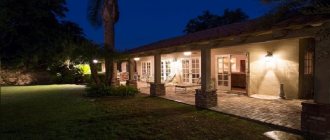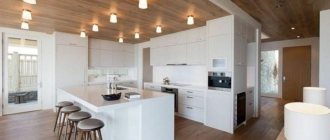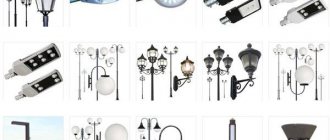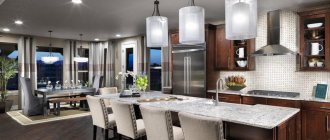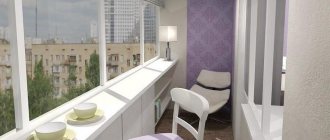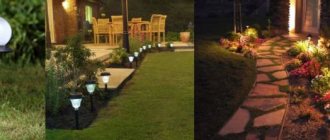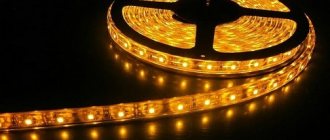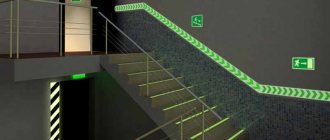Illumination of the house from the outside allows you to improve the appearance of the facade, illuminates the area and highlights the necessary elements of the building. By using light wisely, you can transform a building and focus attention on its features. The important thing is that you can select and install the equipment yourself if you follow the instructions.
Many architects think through lighting in advance as a full-fledged element of the house’s exterior.
Fixtures for facade lighting
The beam of light that needs to be directed onto individual elements of the façade can be created using a halogen or metal halide lamp with a lens or reflector.
With the help of such lighting you can create various interesting lighting effects. For these lamps, you can take any type of light bulb, which will allow you to play with light. As a rule, LED lamps have recently been used, as they save energy and have a long service life - up to 100,000 hours.
The latest know-how in lighting is lamps based on the “sandwich” principle, where there is silicone between the glass walls, and LEDs in the silicone. They are available in various colors, sizes and shapes, and can also be modified according to a given program.
You can also highlight the stairs that lead to the front door. When a person steps on the step, the light comes on.
You can also choose the lighting color. True, such lighting devices are expensive, but maybe soon they will become available to everyone. Moreover, facade LED lighting is very economical.
To illuminate the facade and the area outside, you need to take into account that the light bulbs must be moisture-resistant and dust-resistant. The housing for an outdoor lamp should be aluminum, as it is the most weather-resistant. Based on the manufacturing method, it is better to choose cast lamp housings.
Halogen or metal halide lamps are an excellent choice; they will last four times longer than conventional lamps and save up to 80% of energy. Also, such lamps illuminate the facade with natural bright light.
A house that is lit from bottom to top looks beautiful, and not vice versa. He will appear taller and more beautiful. It is also worth highlighting the house number and street name. Keep in mind that halogen lamps produce a beam of up to 3 meters, and metal halide lamps have a beam of up to 6 meters.
Installation of LED strip
The main purpose of installing an LED strip is to create certain and other elements. An important component in carrying out this work is the accuracy and reliability of fastening.
High-quality and beautiful lighting is possible if the distance between its levels is maintained. It should not go beyond 17-20 cm.
The tapes are secured using corners. They can be aluminum or plastic. Most often, double-sided tape is used for high-quality fastening.
The lighting will hurt your eyes if it is mounted too low. In the opposite situation, when the tape is mounted above the level of the lower border of the ceiling, the light will be insignificant and dim.
A similar scheme is used to attach the LED strip to the .
Corners are used and the guideline itself will be the reference point. LED lighting of this type looks excellent and no less harmonious on ordinary ceilings.
Installation is carried out on a plinth that does not fit closely to the ceiling. The distance between the plinth and the ceiling should not be less than 2 cm.
How to install and connect the LED strip, see the following video:
Facade lighting emphasizes the architecture and design of the house and highlights individual elements. From this article you will learn how the types of lighting differ and how to make lighting for the facade of a house yourself.
Types of facade lighting
There are 6 types of facade lighting. Which one to choose depends on the functions of the building, customer preferences, existing technical limitations, budget and landscape. Lighting techniques can be combined.
Dynamic
Dynamic backlighting is characterized by variability in color and brightness.
Types of lighting fixtures:
- Spotlights;
- LEDs;
- ribbons;
- spotlights.
Dynamic lighting is characterized by color changes.
Contour
In this case, it is assumed that light elements will be placed along the contour of the walls. It is convenient to use flexible neons and LEDs in the shape of different shapes.
The contour lighting concept began to be used relatively recently, so specialists often develop projects from scratch rather than using ready-made solutions
Correctly selected devices help highlight the outlines of the house, focus on corners, columns and other interesting elements.
Contour lighting outlines the outline of the building.
Local
Parts of the façade are illuminated separately.
Local light is used when you need to visually highlight part of the facade. Examples: lighting of windows, doors, cornices, balconies, foundations, basements.
Local lighting projects are used to visually highlight facades made of wood, porcelain stoneware and other materials.
Panel cladding with bright illumination also looks impressive. The main advantages of local lighting are efficiency and versatility.
Lamps are attached to the facade, located in the places provided for by the project. The brightness of the devices is low, the effect is achieved through proper layout.
An alternative option is neon ribbons. They consume less energy than older fluorescent ones.
Background fill
This type of lighting highlights outlines and elements (not necessarily along the edges), but leaves the main part dark. The fill is designed based on LED tubes. They are used to illuminate the facades of theaters, museums, palaces, and concert halls.
The main part of the building remains dark.
Illuminated facades
The sources are positioned so that the rays illuminate the facade from the inside.
Lighting design can be stationary or abundant, adjustable in brightness and color.
Objects for which this façade lighting concept is suitable:
- offices;
- shopping and entertainment centers;
- the shops;
- night clubs.
Lighting is provided from inside the façade.
Flooding
Used to illuminate cultural property.
This type of lighting is suitable for optical highlighting of buildings, sculptures, structures of historical, cultural, artistic or architectural value.
These include monuments, sculptures, monuments, steles, and temples.
Spotlights are placed on the ground or elevated surface and direct the beams so that they shine on the object from different directions.
The light composition is bright, but it has a limitation. Flood structures should not be installed where they will enter windows and create discomfort for people living in nearby buildings or working in nearby areas.
Differences and similarities between dynamic and static backlighting
The differences between the two types of lighting lie not only in the scope of application and intended purpose, but also in the types of equipment used. At objects that require static lighting, both LED spotlights and lamps, as well as devices that work with other types of light sources, for example, gas-discharge lamps, are successfully used.
The most profitable from an economic and practical point of view is the use of LED devices. Sufficient brightness and low power consumption allow this type of device to be used in both cases. Modern LED equipment allows you to fine-tune all lighting parameters from beam brightness to color saturation.
The advantages of LED devices include the following:
- Significantly lower energy consumption compared to incandescent lamps and gas-discharge lamps;
- The absence of harmful gases that can have a detrimental effect on the human body and the environment if the lamp bulb is damaged;
- Higher efficiency ratio, expressed in the ratio of electricity consumed and light generated;
- The versatility of the devices and the ability to use them in various conditions;
- High degree of protection against mechanical, chemical and other types of influence.
In general, LED equipment is the universal factor that combines static and dynamic types of lighting. There are types of devices that are amenable to hardware configuration and are capable of operating in various modes, providing, if necessary, static or dynamic illumination of the building facade.
Other applications of the two types of backlight
In addition to the design of facades, these two types of lighting can be used for technical and interior lighting. Spotlights and lamps are widely used in the advertising business, for illuminating banners and stands.
Pulsating dynamic lighting is used in airport buildings and on highways. Here you can also see multi-colored static lighting used to delimit safety zones and mark potential threats to traffic.
Diode lamps are used to illuminate the facades of swimming pools, sports grounds, the interior of clubs, restaurants and other public places that require the use of high-quality lighting technology.
Determination of quantity
To create a cozy atmosphere in the room, when the lighting is not annoying, but there is no darkness, you need to choose the right power of the lamps, their location and quantity.
There is an easy method for determining the number of lamps: for five square meters of room volume, at least sixty and no more than seventy-five kilowatts of light power should be consumed.
If you turn to a specialist for this task, he will prepare a house lighting scheme with all the details and in various variations. In addition, you can get useful information on installation rules.
Successful options for the location of light sources and their quantity can be seen in the photo of house lighting.
Selecting luminaires and lighting control methods
The choice of types of lamps depends on the type and purpose of the illuminated room. When designing complex lighting installations, such as large office buildings, luminaires and switch locations are usually chosen by designers and architects. Then the designers, in close cooperation with lighting equipment suppliers, carry out illumination calculations for all rooms and arrange the fixtures. When designing lighting for ordinary rooms, the designer performs all the work himself. Preference is given primarily to lamps with maximum luminous efficiency and service life. But it is necessary to take into account the characteristics of the emission spectra of lamps, taking into account their effect on the human body. When choosing lamps, you should take into account the color rendering index, the coefficient of pulsation of illumination, as well as indicators of glare and discomfort. Descriptions of many types of the most widely used lighting fixtures are given in the “Light Fixtures” section.
Selecting lighting control methods. To turn on lamps in small rooms, as a rule, switches are installed indoors on the side of the door handle. In large rooms it is more convenient to control lighting from one place. If there is a security post, then the lighting is controlled from this post. In long corridors, it is convenient to install switches at both ends of the corridor, which allow you to control lighting from two or more places.
At high powers of group lighting lines, magnetic starters (contactors) are used to turn on the lamps, the control coils of which are switched either by conventional switches or using a push-button station. The push-button post contains two separate buttons for turning the lighting on and off. When the lighting is working, the on state of the magnetic starter is ensured by its self-locking.
In bathrooms, showers and bathrooms, switches are installed outside these rooms.
Determining factors and work sequence
When developing a lighting plan, consider:
- External features of housing (color, texture, architectural style).
- Landscape of the site, location of the house on it.
- Where is the point from which the house will look best?
After this, you can start creating the project. Preliminary work consists of several stages:
- First, a general lighting concept is developed and lighting fixtures are selected.
- Electrical networks are prepared taking into account the specified lighting and brightness parameters.
- Equipment (lights, lamps, spotlights) is purchased.
The last stage is the actual installation work and launch of the lighting.
Choosing the location of devices
The placement of lighting equipment is as important a component as the choice of devices. When performing this stage, the designer must analyze both the parameters of the lighting fixtures (type, power) and the features of the structure. TO
As a rule, devices for flood lighting are mounted on separate supports or on objects located nearby. Also, a popular solution is to install devices on special brackets mounted directly on the structure.
Local lighting is often located near the element that it highlights. For large element sizes, the device can be placed on a support, the role of which is played by a protruding part, for example, a loggia.
The general rules for placing architectural and artistic lighting are as follows:
- it is necessary to ensure ease of installation of devices and their maintenance in the future;
- it is necessary to provide the technical possibility of connecting power supplies to the devices;
- a guarantee is required that the lighting equipment will be absolutely safe for people inside and outside the building.
Basic rules for designing architectural lighting
Before creating a facade lighting project, it is necessary to decide what type of lighting to use in order to create the safest and most comfortable conditions for movement around the site and near the house at night, and at the same time, everything is arranged so that the light does not interfere with rest. It is imperative to choose a type of lighting fixture that would effectively perform its task and at the same time serve as a unique decoration for the home.
If you use light correctly, the exterior can be endowed with notes of modernity, the Middle Ages, etc. To improve the lighting effect of the facade, you can place several spotlights around the country house so that their light evenly illuminates the building. An equally effective option is when light elements are installed pointwise on the facade in such a way that their rays beautifully highlight the architectural elements of the building.
An important detail: not every type of lighting can be used to design architectural lighting for the facades of buildings outside the city. The arrangement of flood lighting is considered unacceptable - private houses are usually low, and this option is intended for high-rise buildings. In addition, flood light will enter the windows, so all rooms will be very bright at night, which can make it difficult to sleep at night.
Designers strongly recommend using down-light lighting devices to illuminate the facade of a cottage, as they have important advantages: the devices are compact, but have the same power as small spotlights, and they can also change the angle of the lamps to more effectively obtain light spots
Equally interesting for creating decorative lighting for building facades are devices with halogen directional light lamps. Their use has the following advantages:
- In devices of this type, the direction of the beam and the radius of illumination are adjustable.
- The devices are compact, so they do not take up much space.
- The operation of lamps allows you to save money - LED lighting of the facade of the house consumes very little energy.
- Efficiency. When using devices of this type, the flood of light can be made powerful and uniform.
Overhead lighting fixtures look especially advantageous on building facades. Such lamps can be combined with strobes, bollards, and colored illumination. To illuminate the area in front of the building, you can install decorative lanterns and special lighting devices on supports.
Not only the lighting of the facade of the house requires attention, but also the porch. It is best to equip the space near the front door with lamps that diffuse light. Thanks to the reflectors, the light will be evenly dispersed throughout the space closest to the house. If you are arranging not only lighting for the facade of a private house, but also the landscape around it, it is necessary to create the entire composition in the same style. Only this approach guarantees a beautiful and harmonious design of the site as a whole.
Before creating an architectural lighting project, you need to make sure that it is economical and easy to use. To do this, you need to divide the object into the following zones:
- Entrance. Both the main and side entrances, if any, are taken into account.
- Secondary areas that also need to be illuminated.
Illumination of country houses: a little history
Designer Elena Golubkova has already told FORUMHOUSE readers about the role light plays in the interior of any building. It is no less important in the exterior: a well-designed outdoor lighting system can transform even an ordinary wooden building into a masterpiece without rebuilding or expensive finishing. Architectural lighting allows you to protect your home from thieves, and you from having to look for the keyhole in the dark.
Of course, facade lighting is not an invention of today. Torches were attached to the walls of buildings back in Ancient Rome, caring not so much about the beauty of the buildings, but about illuminating the streets at night. Torch lighting was common in Europe until the invention of kerosene lanterns and electricity - torch holders are now available on the outside of many buildings in England, France, and Italy. “Florence comes to me, phosphorescent with its houses, and, like a butler, unlocks its palazzos and fogs,” the poet Andrei Voznesensky shares the image in the poem “Florentine Torches.”
We talked in detail about how architectural lighting has evolved from torches to LEDs in our article. Our experts tell us how modern home lighting works.
How to implement artistic lighting
It can be implemented in several ways:
general light fill With its help you can illuminate a separate building among the total mass;
local illumination The goal is to highlight several architectural fragments
Please note: if there are repeating parts, their lighting will give special expressiveness;
contour lighting It allows you to indicate the silhouette of a building using light. The building can be illuminated as a whole or in separate fragments
This way you can draw attention to columns, spiers and other elements;
background illumination The goal is a special background of the building due to color. The backlight can be made movable and create an amazing play of light and shadows;
various projections This refers to various images that are usually projected on the facade and can move;
hidden lighting Designed for lighting stairs, lighting bridges, fountains;
combined lighting Involves the use of several types of lighting at once;
media façade is a type of façade illumination designed to change the color and intensity of the illumination. Controlled by a computer system.
Architectural lighting of a residential complex
Basic techniques of architectural lighting
Before we begin to consider the different types of lamps that can be used to organize a lighting system, it is necessary to understand what types of architectural lighting there are. Depending on the type of object and the desired result, there are 7 lighting methods:
General or flood – used when it is necessary to highlight a separate object or structure, including large cultural monuments, churches or cathedrals. Russian Orthodox Church including.
This type of lighting can be realized using RGB, white and amber spotlights for artistic lighting of buildings. The method allows you to fully convey the significance and scale of the object, as well as ensure its holistic perception. The entire object and some part of the surrounding area are illuminated. However, it is necessary to understand that with flood lighting, spotlights are installed directly in front of the building, at some distance from it, or on poles and directed towards the facade. Therefore, some of the rather bright light will constantly appear through its windows, which can cause significant discomfort. Because of this, it is not recommended to choose a similar lighting system for buildings where people are constantly present, for example, for hotels or large office centers;
Local lighting – used to highlight any individual element or small area. This could be, for example, a beautiful cornice or balcony, a frieze, an unusually shaped window opening or a vault
This technique is designed to draw attention to spectacular details that may otherwise go unnoticed. To implement such lighting, wall lamps of small size and low power are most often used, which are mounted directly near the illuminated object.
Linear LED lamps can also be used, which are significantly smaller in size than conventional fluorescent lamps;
Background or silhouette lighting is implemented using powerful flood-type spotlights, which are installed in front of the object at a certain angle. Their task is to create a luminous background, which will become an advantageous basis for effectively and clearly highlighting the contours of the facade. Most often, this type of lighting is used when it is necessary to emphasize the grandeur and beauty of various castles or theaters, buildings with columns. Contours become clear, graphic and pronounced;
Contour lighting – implemented using linear LED lamps. From the name it is clear that lighting fixtures are installed along the contours of a particular object and favorably emphasize non-standard silhouettes;
The “light façade” system is used to illuminate modern multi-story business or shopping centers. In principle, it can be used for any objects whose facades are made of plastic or glass. The difference between this system is that the lighting fixtures are installed behind glass, and their luminous flux is directed onto the window opening in such a way that a static or dynamic effect is created. The lamps themselves can be either monochrome or RGB;
Color-dynamic lighting is implemented using controllable spotlights, LED strips, spotlights and other lamps. This lighting system can be used in all of the above types, that is, it can be both flood and contour, etc. Its difference lies in the fact that controllable lamps can operate in different modes - with smooth fading and increasing brightness, with changing the color spectrum and color synthesis, which allows you to achieve amazing effects. Such lighting is widely used to create special fountain designs;
Illumination in the form of color graphics is also created using controllable lamps that can change the color of the glow depending on the applied brightness. By adjusting this parameter, interesting color patterns are created on building facades, which can consist of either solid luminous lines or individual dots.
LED strip - design element
LED products are complex lighting structures. Their choice for home decoration depends on the complexity. It is recommended to invite specialists for installation to avoid incorrect installation.
Which in turn can cause a short circuit or other troubles. Minimalism in interior design with furniture will allow you to fill in the missing elements with the help of an LED strip.
Take note:
Multi-colored LED strip is especially relevant for arranging staircases in cottages.
You can create unique comfort in a spacious room by highlighting some pieces of furniture with bright light and dim light on others. Weightlessness and transparency are created by attaching the tape to the ceiling along its contour. At the same time, place a large number of small light bulbs in free “flight”.
Types of architectural lighting
General façade lighting
Lighting devices are mounted in such a way as to provide illumination of the main elements of the object. General architectural lighting and building lighting are used to create a specific urban style, drawing attention to individual buildings. By manipulating the degree of illumination, you can differentiate them by status and rank. For example, state, municipal, district, etc.
Flooding Light
LED lighting of building facades using medium-power lamps can convey the monumentality of a composition, combining various elements into a single whole. More often it is ordered for the design of historical, cultural and non-residential objects: monuments, temples, churches, etc. Directional spotlights are mounted on the ground or on small supports.
Hidden lighting
Sets of small-sized lighting devices are used when it is necessary to discreetly create a unique look or emphasize the decorative details of a building. A good option is overhead LED spotlights of medium power or other compact lamps with small dispersion angles. The combination of different shades allows you to create a mesmerizing light aura around protruding cornices, balconies, columns or other volumetric structural elements.
Contour lighting
Installing lamps along the contour allows you to effectively highlight the silhouette of the building against the background of a dark space. In this case, it is possible to emphasize not only the outer edges of the object, but also the configurations of specific structural elements. To design contour-type architectural lighting, linear LED lamps, strips and neon tubes are in demand.
Decorative lighting
A suitable way to create an original look using certain elements of the building's architecture
By highlighting specific details, designers focus attention on the attractive aspects of the design, hiding, if necessary, less refined aspects. Various types of lamps are used for decorative lighting
However, the most practical and economical are LED devices.
Dynamic lighting
The attractiveness of such illumination lies in its mesmerizing spectacle. You can buy dynamic LED lighting for advertising purposes, on New Year's Eve or other major holiday. The use of various lamps makes it possible to create drawings, figures, animations, and other lighting effects with control of shades, shapes, brightness and other parameters.
Kinds
All existing varieties of such devices can be divided into flood light devices, local and hidden lighting.
- Spotlights are halogen or LED models with a bright and directional light output. Depending on the type of location, they can be panoramic or angular.
- Built-in varieties include wall sconces in the form of lanterns.
- Floor lamps belong to the class of double-sided lamps. These sconces are functional and suitable for lighting entrance areas, adjacent areas, as well as signage signs. They can be used to fill the main space with light, to design a veranda or terrace, or to illuminate small areas of the facade.
In addition to these varieties, linear or tape-type products are popular options. These are special diode LED lamps in the form of a flexible strip. LED strip lighting allows you to identify architectural elements, highlight the contours of the roof, and create an interesting pattern. It can be hidden behind the cornice, stucco molding, and elements of the entrance group.
Ground varieties are fixed near the building. More often the base is a concrete base, tiles or asphalt. Such models are protected from moisture and accidental mechanical damage. During installation, you can give them the desired angle of inclination of the light flux. This allows you to create a special light composition. Lighting sources can have different shapes (from retro and classic models of lamps to ultra-modern new products or products in the form of figures, as well as overhead analogues).
LED strip in the external facade of the house
In recent times, LED lighting of various types was used mainly for decorating sculptures and monuments.
Gradually, similar experiences were adopted when decorating public buildings. Private houses illuminated with LED strips look especially colorful, elegant and festive on the eve of the New Year holidays.
Installing tape on the facade of a house is not a very difficult job. It is necessary to have devices for manual fastening of the product. In advance or simultaneously with the purchase of lighting devices, purchase a low voltage cable and insulating tape.
The lighting is installed and the whole process is regulated, focusing on the source of connection to the general energy saving system of the house.
